Upper Silesian operation
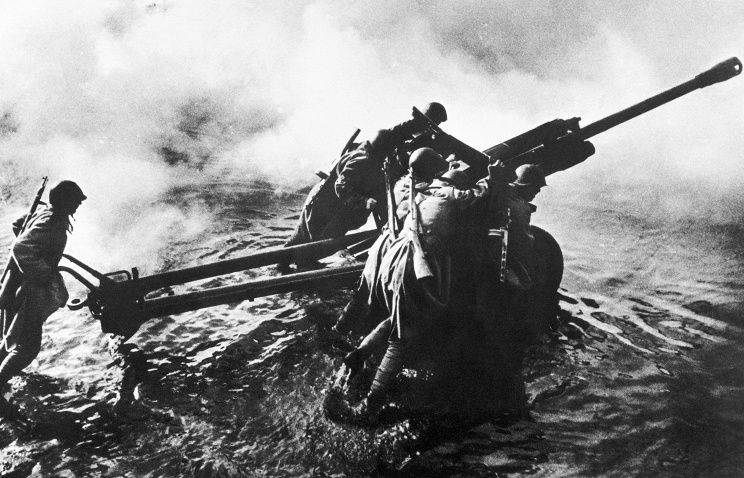
15 March 1945, the Upper Silesian offensive began. It was conducted by the troops of the 1 of the Ukrainian Front under the command of Ivan Stepanovich Konev in order to eliminate the threat of a flank strike and seize the Silesian industrial region. Soviet troops broke through the enemy defenses, surrounded and destroyed German divisions in the 5 Opple Squad, defeated the enemy grouping in the Ratibor area. As a result, Soviet troops captured the south-western part of Upper Silesia, reached the line of Strehlen, Neisse, Sudet foothills (south of Ratibor), taking advantageous positions for the development of an offensive in the Dresden and Prague axes. The Konev Front had the opportunity to focus on the preparation of the Berlin operation.
prehistory
During the February Lower-Silesian operation (Battle of Lower Silesia) troops of the 1st Ukrainian Front defeated the 4th German tank army, went to the Neisse river and occupied part of the Silesian industrial region, which weakened the economic power of the Third Reich. German garrisons were surrounded in the fortresses of Glogau and Breslau (about 100 thousand people). Our troops hung over the Upper Silesian enemy grouping and created the conditions for an attack on the Dresden direction and the liberation of central Czechoslovakia.
However, due to a number of reasons, all the tasks of the operation were not solved. The offensive could not be carried out to a considerable depth, to develop in the Berlin direction. The offensive began without respite after the Vistula-Oder operation, the troops did not have time to rest, to replenish manpower and equipment, to conduct appropriate training. Communications were greatly stretched, the railways did not have time to recover, the nearest supply stations were greatly removed, which led to a shortage of ammunition, fuel and other supplies and materials needed by the troops. The situation on the flanks also affected the offensive. The 4-th Ukrainian front led heavy fighting in Czechoslovakia and moved slowly, and the 1-th Belarusian Front solved the task of eliminating the threat from Eastern Pomerania. In addition, the Soviet command underestimated the enemy. The Germans with the help of rear reserves were able to fairly quickly restore the combat capability of the divisions defeated during the Vistula-Oder operation and create a new strong line of defense. German troops defended stubbornly and put up strong counterattacks, remaining a formidable opponent.
In the course of the Lower Silesian operation, the offensive of the left (southern) wing of the front was stopped on the third day, and the center and especially the right wing of the front advanced significantly. As a result, the front line, which was formed after an offensive operation, gave both sides the opportunity to conduct offensive operations. The Wehrmacht from the Oppeln area could deliver a flank attack in order to unblock the Breslau garrison, and if successful, try to restore the front line on the Oder. And the left flank of the 1 of the Ukrainian Front hung over the group of German troops in the Oppeln - Ratibor area.
After the completion of the Nizhne-Silesian operation 1, the Ukrainian front was actively restored: the troops received reinforcements, weapon, equipment, ammunition and all the necessary materials, the rear was put in order, the railways and airfields were restored.
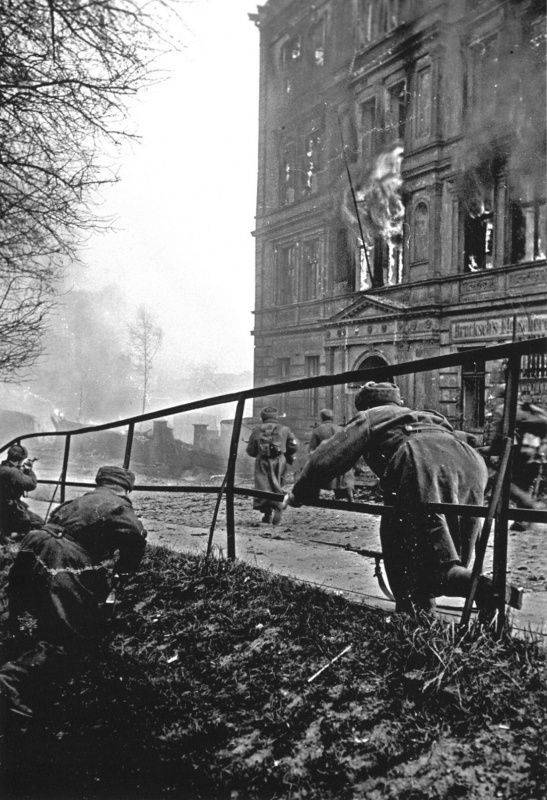
Soviet infantry in street battles for the city of Neisse
Operation plan
The Soviet leadership was worried about the fact that after the loss of the Silesian industrial region, the German command was holding against the southern wing of the 1 of the Ukrainian Front a fairly significant grouping of troops and continued to strengthen it. Apparently, the Germans were still hoping to repel the "second Ruhr." As Konev, the commander-in-chief, recalled, Supreme Commander Joseph Stalin repeatedly called him and “persistently called my attention to the fact that the Nazis were going to strike us in the south, in the direction of the raions, intending to regain the Silesian industrial region.” The same was reported by the Head of the General Staff Alexey Antonov. Konev expressed confidence that our troops would not yield to Silesia and said that the front command was preparing an operation on the southern wing in order to eliminate the enemy grouping in the Ratibor region.
Thus the idea of the Upper Silesian operation arose. Its goal was to defeat the enemy's Oppelno-ratiborskaya grouping and level the front in order to create conditions for a future Berlin operation. The Soviet command planned to surround part of the German group, which was located on Opplean ledge and directly at Oppeln. The city itself was still partially occupied by our troops during the previous operation. Soviet troops had to deliver two converging strikes in the direction of Neustadt (Neustadt), surround and destroy the enemy grouping in the Oppeln area and go to the Sudetes. In order to speed up the advancement of troops, the front command decided to throw tank troops into battle simultaneously with the advancing infantry. The beginning of the attack was scheduled for March 15.
To solve this problem, two shock groups were formed - North and South. The Northern grouping consisted of: one corps of the 5 Guards Army commanded by Zhadov, the whole 21 Army of Gusev, the 4 Guards Tank Corps of Poluboyarov and the 4 Panzer Army of Lelyushenko (during the battle it received the title of Guards), which was transferred from right flank of the front. The southern (Ratibor) group consisted of Korovnikov's 59 Army and Kurochkin's 60 Army, which reinforced the 93 rifle, 7 Guards mechanized, 31-m tank corps and the 152-th separate tank brigade. Both groups were significantly strengthened by artillery. From the air, the advancing troops were supported by the 2-I Krasovsky Air Army.
The forces of the parties
THE USSR. The operation involved 31 Soviet division, in total more than 400 thousand people, 5640 guns and mortars, 988 tanks and SAU, 1737 aircraft.
Germany. Our forces were opposed by part of the forces of Army Group Center. The Upper Silesian group included the 17th Army of F. Schulz, the Army Group Heinrici G. Heinrici (1st Panzer Army). From the air, the grouping was supported by part of the forces of the 4th Air fleet. In total, before the start of the operation: about 20 divisions, 60 separate battalions, 1420 large-caliber guns and mortars, about 100 tanks and self-propelled guns, 750 combat aircraft.
German troops on the southern wing of the 1 of the Ukrainian Front actively tested our positions and at the same time continuously strengthened their defensive positions. In five weeks of relatively lull, German troops not only strengthened the field-type defense, reinforced by various barriers, but also created defense centers in the rear, prepared settlements and separate stone buildings for the all-round defense. A dense network of settlements contributed to the defense. The depth of defense reached 20-25 km. At the same time, on Oppelskiy ledge, the German troops had rather dense defensive orders: one division accounted for approximately 8 km of front.
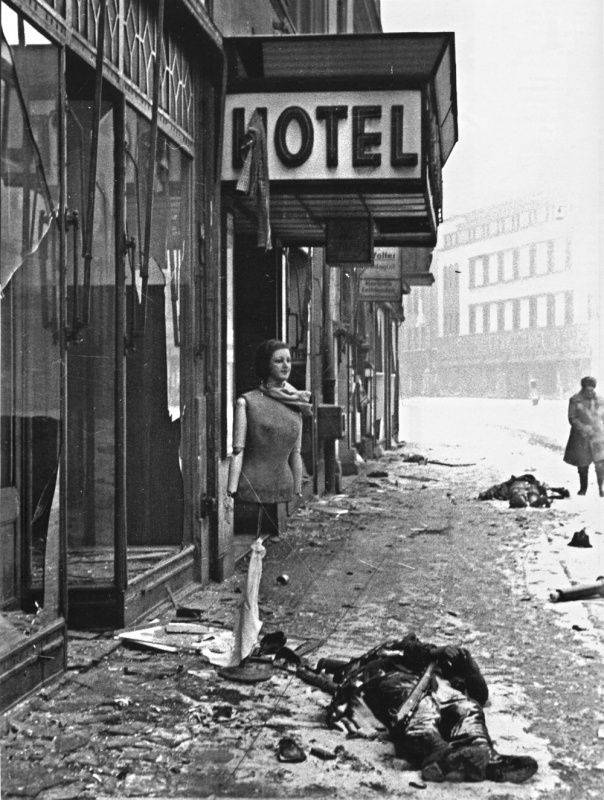
One of the streets of the German city of Oppeln, occupied by Soviet troops
German counterattack
German intelligence was able to obtain information about the impending Soviet operation, and the German command organized a counter-offensive. The Germans decided to strike at the Soviet bridgehead between Kozel and Ratibor. The Germans planned to defeat the concentrating Soviet troops and destroy the bridgehead. On the night of 8 in March 1945, the German troops launched an attack. The jaeger group (97-Ieger Division and 1-Ski and Chasseurs Division) struck. The von Pappenheim strike force was supported by the 11 Army Corps von Bünau, which held the front line in this area. Initially, the counter attack successfully developed. Rangers were advancing north along the bank of the Oder, and parts of the 11 Corps towards the Jäger group from the west. But soon the offensive died down, the Germans were able to recapture only a few kilometers of the bridgehead, and went over to the defensive.
Battle
The first stage. On the morning of March 15, 1945, after 40 minutes of artillery preparation, our troops went on the offensive. Soviet troops met stubborn resistance of the enemy. The fierce resistance of the German troops, combined with the spring thaw and rough terrain, as well as strong mining, sharply reduced the pace of our troops. The spring thaw deprived the tank units of the ability to maneuver. You could only step along the roads. In addition, due to bad weather aviation in the first half of the day was inactive and could not support the ground forces that day in full force. On the first day of the offensive, the Northern Group created a gap at the front of 8 km and advanced inland also by 8-9 km. The southern group advanced into the enemy defenses by 10 km.
It is also worth considering that the Soviet command made a miscalculation. After the advanced units of the 21 Army Gusev took the first trench quite easily and broke into the second, the commander decided that the job was done and reduced the intensity of the artillery fire by half. Gusev wanted to save ammunition that could be used in the subsequent stages of the offensive. However, the offensive soon slowed down. Artillery preparation could not destroy most of the enemy firing points. The dug-in tanks, assault and anti-tank guns hidden in the settlements were a surprise to our troops. It was difficult to detect such points from the air, and military intelligence could not identify them in the short period of preparation for the operation. Now they entered the business and became an unpleasant surprise for our troops. As a result, the Soviet troops not only lost the pace of the offensive, but also suffered unnecessary losses. So 4-I Guards Tank Army suffered great losses.
The Soviet tankers in this battle were faced with the massive use by the Germans of the latest modifications of the Faustpatrons - panzerfausts, which were particularly effective during battles in densely populated areas. As in the northern sector, reconnaissance in the south was insufficient, which led to a weakening of artillery fire. As a result, tank units suffered serious losses. Thus, the 7-th Guards Mechanized Corps operating in the Southern grouping lost a quarter, and the 31-th tank corps - a third of its tanks.
In order not to give the enemy time to come round at night, our troops continued the offensive. The second echelons of regiments and divisions were introduced into battle. The Soviet command had foreseen such an opportunity and in each division formed one reinforced battalion for night battles. These battalions fought only at night, and during the day were assigned to rest. In night battles, artillery supported such battalions with direct fire. Before the onset of darkness, the guns allocated for night fights were pushed forward as far as possible.
Already 15 March, the German command began to push reserves from the depths. It must be said that the Germans underestimated the impact force of the Soviet front and missed the appearance of the 4 tank army of Lelyushenko, therefore there were no serious reserves near the Soviet bridgehead, they had to be advanced from the depths. March 16 began fierce oncoming battles between the advancing Soviet and counter-German forces. The first to join the battle were the German 19-I tank division and the 10-I tank-grenadier division. They were already battered in previous battles and could not close the gap. Later, units of the 20 Tank Division pulled up.
Particularly stubbornly, the Germans attacked the positions of the 5 Guards Army, which covered our main attack from the north. Apparently, the German command, as it was already more than once in the past, tried to pull down the base of the Soviet strike wedge. However, the Soviet command provided for such an opportunity and on this section German counterstrikes reflected tested military units — the 34-th Guards Rifle Corps of GV Baklanov and the 4-th Guards Tank Corps of P. P. Poluboyarov. The Wehrmacht stubbornly and unsuccessfully attacked these corps, but this did not affect the onset of our main attack force. In addition, the weather improved, and front aviation began to provide serious assistance to ground forces.
By the end of March 17, our troops had broken through the tactical zone of the enemy’s defense, mobile units were inserted into the gap. On this day, Nil Danilovich Chuprov, commander of the 10 Guards Tank Corps, who had gone through a glorious combat career since the beginning of the war, died in battle. The corps was headed by the Deputy Commander of the 4 Tank Army Major General E. E. Belov. In the afternoon of March 18, units of the armies of Gusev, Lelyushenko and Korovnikov met in the area of the city of Neustadt. By the evening of the same day, the 61-I Guards Tank Brigade of V.I. Zaitsev took Neustadt on the run. And the main forces of 10 of the Guards Tank Corps under the command of Belov reached the area of Zulz, where they merged with parts of the 7 of the Guards Mechanized Corps of General I. P. Korchagin, advancing from the east.
Having completed the encirclement of the Opplena grouping of the enemy, the Soviet armies turned part of the forces to the west and created the 20-kilometer lane between the surrounded grouping and the main forces of the 17 German army. There were about five enemy divisions in the Opel of the “boiler”: the 168 and 344 infantry divisions, the SS 20th infantry division, some of the SS 18 motorized division and several separate regiments and battalions, an artillery regiment, 9 artillery fighter, and 45 artillery. other parts. In total, about XNUMX thousand enemy soldiers and officers were surrounded. Konev ordered in the shortest possible time to finish with the surrounded enemy grouping.
18-20 March, our troops repelled powerful attacks from an enemy who was trying to save the surrounded units. On the night of 18 in March, the German command threw into the attack the remaining reserves, including the elite tank division “Hermann Göring” that had just been transferred to this section of the front. The command of Army Group "Center" tried to stabilize the front by transferring connections from other sectors of the front to the Neuss area. As a result, the plan of deblokade Breslau was thwarted.
The Germans were advancing from the Neisse region. The 6 th Guards Mechanized Corps of V.F. Orlov, which was reinforced by an artillery brigade, first entered the battle against the enemy. Hard fight lasted two days. The Germans made one attack after another. Separate settlements and frontiers more than once passed from hand to hand. In these fierce battles, the commander of the 6 Guards Mechanized Corps, Colonel Vasily Fedorovich Orlov, the commander of the 17 Guards Mechanized Brigade, Hero of the Soviet Union, Lieutenant Colonel Leonid Dmitrievich Churilov and Corps Reconnaissance Major Major Chernyshev were seriously injured. However, they did not leave their posts and continued to lead the troops. A few hours after being wounded, the commander Vasily Orlov, a brave soldier and favorite of the whole army, passed away. The corps was headed by Colonel Vasily Ignatievich Koretsky, chief of the corps headquarters.
On March 20, the German command threw even more powerful forces into battle: the Hermann Goering Division, the 10 Army Corps, the 20 Tank Division and the 45 Infantry Division, a brigade of assault guns. But the troops of the corps: the 118 th rifle (21 th army), the 6 th mechanized (4 th Guards Tank Army) and 4 th Guards Tank (5 th Guards Army) repelled the enemy attacks. In addition, in the south of the Leobšutz area, the unblocking counter-attack was to be inflicted by the troops of the 24 tank tank of Nering: the 16-I and 17-I tank divisions, the 78-I assault division and the Guard of the Führer. But they did not have time, the Soviet troops destroyed the "boiler". As a result, the 24 tank corps only closed a huge gap, which was formed after the encirclement of the opposition group.
Meanwhile, the 10 Guards Tank Corps, the 7 Guards Mechanized Corps, and the main forces of Gusev’s army and Korovnikov’s army units ended the Opple group. The Germans themselves "helped" with their liquidation. The commander of the 344 Infantry Division, General Yolasse, fearing that the surrounded troops would not get outside help, decided on an independent breakthrough. 19 March he led the troops to break through. The forces of the 344 Division and the 18 Division of the SS participated in it. The rest of the German troops who were defending south-west of Oppeln, in fact, were abandoned to their fate. The principle of “every man for himself” began to operate. Soviet artillery swept through all the enemy’s battle formations, and the bridges in the path of the Germans were prudently blown up. Therefore, very few have made their way to theirs.
By the evening of March 20, the surrounded German troops were defeated, and by the morning of March 22 were completely destroyed. Only the killed Germans lost about 30 thousand people, captured about 15 thousand people. Were captured significant trophies. March 24 part of the 21-th combined-arms and 4-th Guards Tank armies after stubborn street fighting took Neisse. At this the first stage of the Upper Silesian operation was completed.
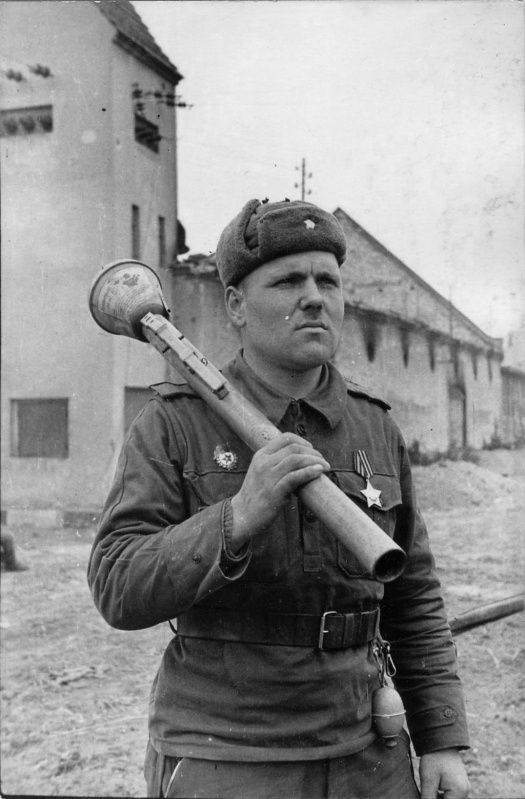
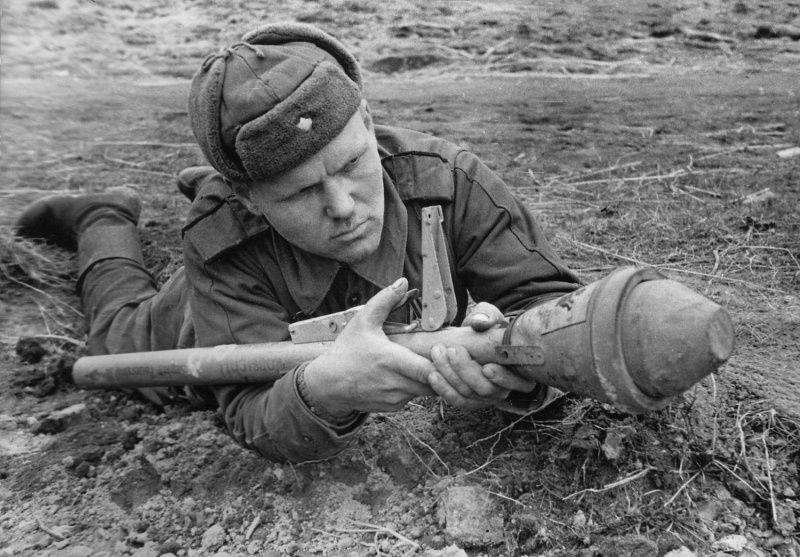
Guards senior sergeant Ilya Amelin from the 15 Guards Rifle Division with the captured German Panzerfaust grenade launcher. 1-th Ukrainian Front.
From the award list: "March 18 1945, Comrade Amelin picked up a German jet gun and, with the third shot, set fire to one of two German self-propelled guns near the village of Niklasdorf, Silesia." Source: http://waralbum.ru/
The second stage. The Soviet troops began the next phase of the operation - the capture of Ratibor, which was the last major industrial center of Upper Silesia. This task was to solve the 60-I army of Pavel Kurochkin. The army was significantly strengthened, it was given four tank and mechanized corps, and first one, and then two artillery breakthrough divisions. However, despite the powerful artillery and air support, the attack on Rybnik and Ratibor developed slowly. The Germans stubbornly resisted, went into counterattacks. On the first day, our troops advanced only 8 kilometers. In the future, the resistance of the Wehrmacht increased even more, the German command transferred the 8 and 17 tank divisions from other directions.
The front command sent two corps of the 4 Guards Tank Army, Lelyushenko, to help Kurochkin’s army. Mobile connections had to strike a powerful blow from the north. March 24 The 5 Guards Mechanized Corps, which was included in the army of Lelyushenko, launched an offensive. The army of Lelushenko was advancing in the direction of Troppau, and part of the forces was to capture Egerndorf and Biskau. In the second echelon was 10-th Guards Tank Corps. However, the first attacks had only limited success. German troops, relying on previously prepared strong positions, stubbornly defended themselves. The 5 Guards Mechanized Corps could advance only 3-4 km.
25 March entered into battle 10-th Guards Tank Corps. The German command responded by introducing the remnants of the 16 and 17 tank divisions into battle, and the elite division “Guarding the Fuhrer” (tracking division of the Fuhrer) was to interpose between the 5-th Guards Mechanized and 10-th Guards Tank Corps. The Soviet command had to bring the 28 Guards Mechanized Corps into battle in March 6.
Soviet troops slowly broke through enemy defenses. Day after day there were fierce battles for small towns, heights, communications nodes. The troops suffered serious losses. Only after the 38-th Army of Moskalenko of the 4-th Ukrainian Front changed the direction of the strike and began to storm the Moravian-Ostravsky industrial area from the north (Moravian-Ostravskaya offensive operation), the situation changed for the better. 24 March Moskalenko’s army struck a blow at the enemy and broke through its forward positions.
This changed the situation on the left flank of Kurochkin's army. There was a threat of encirclement of the German troops in the area of Rybnik and Ratibor. On March 27, our troops took Rybnik and one corps crossed to the left bank of the Oder south of Ratibor. 29-30 March, Soviet aviation delivered powerful blows to German positions in the Ratibor region. In the German positions, the newly arrived 25 th artillery division of the breakthrough, as well as most of the 17 th artillery breakthrough division, fired. After a powerful aviation and artillery preparation, the 15 and 106 rifle corps of the Kurochkin army, with the support of Lelyushenko’s tank army, launched a decisive assault on Ratibor. The Germans could not stand it and began to retreat to the south-west. March Xnumx Ratibor have taken. On this the main part of the operation was completed.
The tank army Leluszeko completed the operation a bit later than the main forces. March 28 The 6 Guards Mechanized Corps struck and broke through the enemy defenses. Great help was provided by the 2-I Air Army Krasovsky. The 6 Guards Mechanized Corps advanced 10 km deep into the enemy’s defense and created a direct threat to the surrounding of the Fuhrer’s Guard Division, the Germans broke and began to retreat, freeing the way for the 10 Guards Tank Corps. German defense collapsed. On April 1, parts of the army of Lelushenko joined in Resnitts and completed the encirclement of the Biscau enemy group. The entourage included units of the 1 th ski and jäger division, the division of the Fuhrer’s Guard and the penal battalion. On April 2-3, the surrounded group was dismembered and destroyed by the troops of the army of Lelyushenko and Kurochkin.
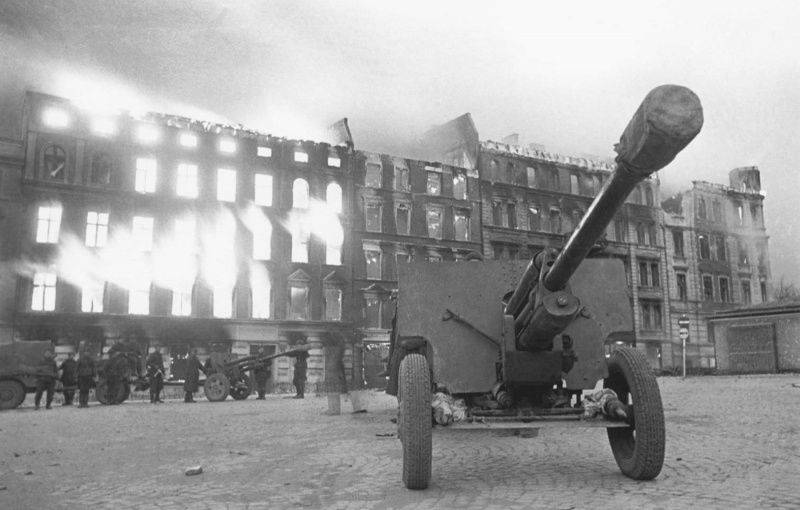
Captain Krynkin's artillerymen in Neisse, Germany
Results
During the 16 days of the offensive, Soviet troops liberated the south-western part of Upper Silesia and reached the line of Strehlen, Neisse and South of Ratibor (Sudet Foothills), occupying an advantageous position to continue the offensive in the Dresden and Prague directions. The threat on the southern flank of the 1 of the Ukrainian Front was eliminated; Konev's armies were able to concentrate all their efforts to prepare the offensive on the main Berlin direction. The Third Reich completely lost control over the most important Silesian industrial region, which led to the loss of a quarter of the potential of the German military industrial complex.
German troops lost about 60 thousand people (about 40 thousand people killed and 20 thousand thousand prisoners) during this battle only killed and captured. Our troops captured rich trophies, including 243 military stockpiles. The loss of Soviet troops - more than 66 thousand people, of which irrevocable - about 17 thousand people. Thus, in the course of the battle, Neil Danilovich Chuprov, commander of the 10 Guards Tank Corps, and 6 Guards Tank Army 4 Guards Tank Army, Vasily Orlov, fell in battle. Both commanders fought on the front since the beginning of the Great Patriotic War and went a long way of fighting.
Sources:
Isaev A.V. Berlin Berlin 45. Battles in the den of the beast. M., 2007.
History Great Patriotic War of the Soviet Union 1941-1945 (in 6 volumes). M., 1960-1965 // http://militera.lib.ru/h/6/index.html.
Konev I.S. Forty-fifth. M., 1970 // http://militera.lib.ru/memo/russian/konev_is2/index.html.
Korovnikov I. T. et al. On three fronts. Fighting path 59-y army. M., 1974. // http://militera.lib.ru/h/sb_na-tryoh-frontah/index.html.
D. Lelushenko Moscow-Stalingrad-Berlin-Prague. Notes commander. M., 1987 // http://militera.lib.ru/memo/russian/lelyushenko_dd/index.html.
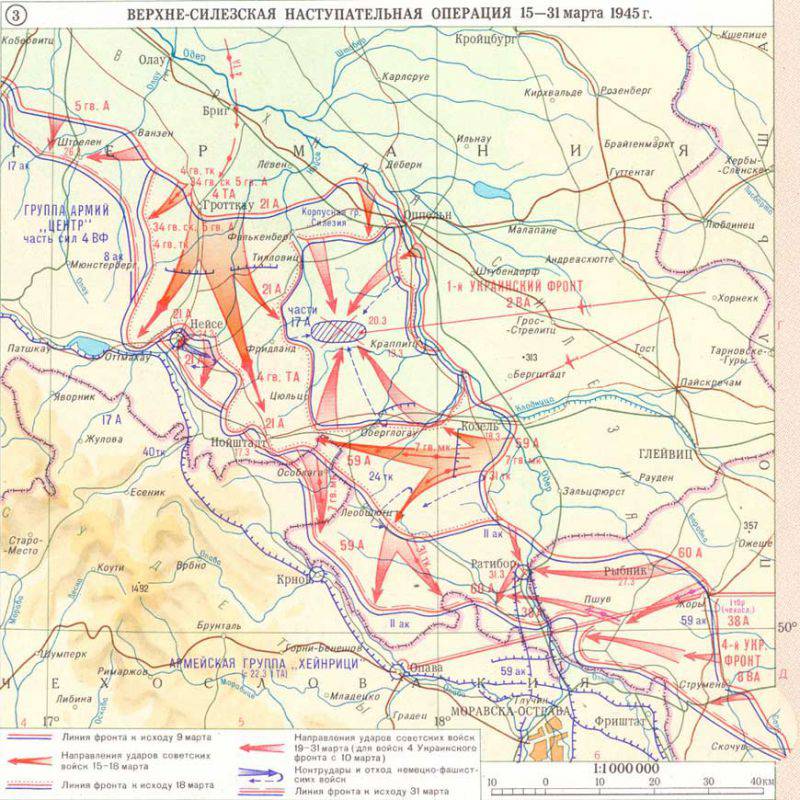
Information